Discover the Cool, Unusual Horned Lizard
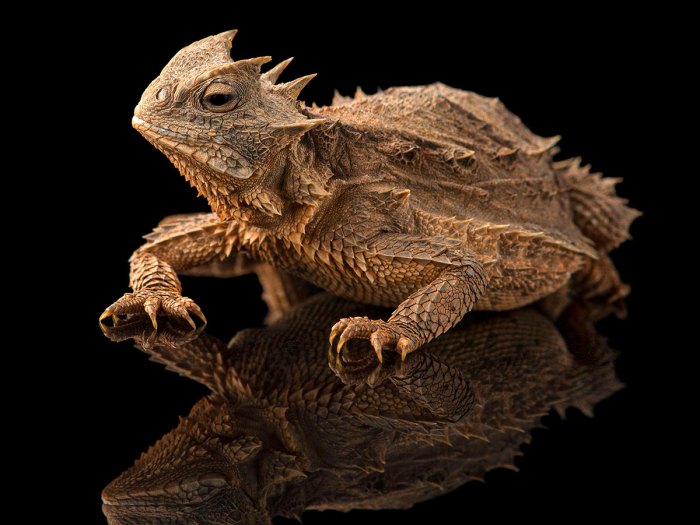
Texas horned lizard
What’s that strange-looking creature? A little armored tank? A walking cactus? No, it’s a horned lizard, one of the most unusual reptiles in the U.S.
NOT FROGS OR TOADS
Horned lizards get their name from the horns on their heads and spikes along their bodies, which give them a tough, intimidating appearance. While they are called “horned toads” or “horned frogs” because of their shape and size, they are lizards, not amphibians. Their flat, wide bodies are unlike those of other lizards, which typically are long, narrow and built for speed.
There are 17 species of horned lizards, ranging from southern Canada to Mexico. Nine are in the U.S. — all west of the Mississippi River — although a few small isolated populations have been introduced in the Southeast. They generally live in hot, dry habitats like deserts and plains, but some are also in open woodlands.
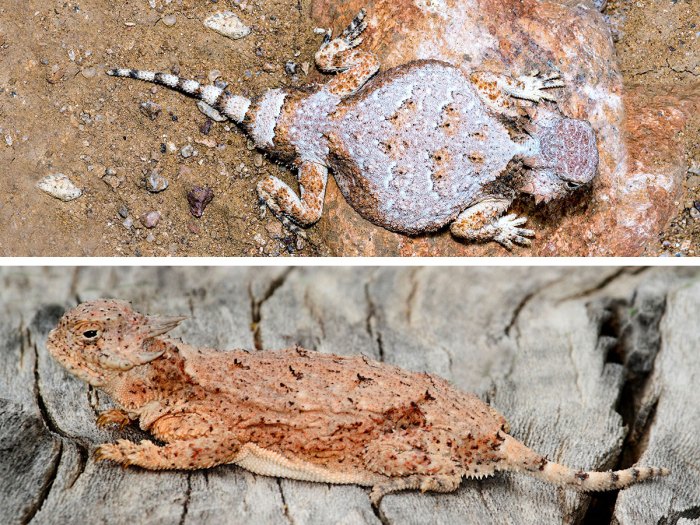
The round-tailed lizard, like its name hints, has a cylindrical tail with colored bands.
WHAT’S ON THE MENU? ANTS!
Horned lizards are active mostly during the day, but they are ambush predators, and their camouflage helps them blend in among rocks, sand and other background elements. So they sit motionless and wait for prey to walk by, and then capture them with their sticky tongues. They eat mostly ants, with some species eating 100 or more per day, since ants don’t provide a lot of calories. Horned lizards have large stomachs to accommodate eating so much, resulting in their wide body shape.
Harvester ants are favored prey for many horned lizards, but they must be captured carefully. The lizards aim their tongues for the ant’s midsection so they aren’t stung or bitten. Spiders, pillbugs, beetles, grasshoppers and other arthropods are also on the menu.
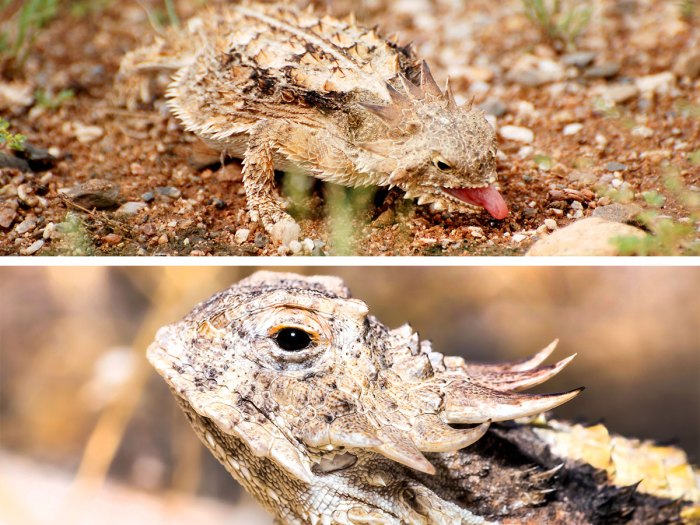
Top: At Saguaro National Park in Arizona, a regal horned lizard eats an ant. See it under the tongue? Bottom: The horns of the regal horned lizard are quite long and resemble a crown.
SECRET DEFENSE WEAPON
Horned lizards are not very fast, so they rely on their excellent camouflage and staying still to avoid detection. They also can flatten themselves against the ground — so flat that they barely cast a shadow! Their horns and spikes provide some protection from predators such as snakes, roadrunners, coyotes, ravens and hawks. Horned lizards can also puff themselves up with air to make themselves look bigger and more menacing, which also makes them harder to swallow if caught.
When in danger, eight species of horned lizards also have another trick: They can squirt blood from the corner of their eyes as a last defense. Whoa! This bizarre technique is mainly used against mammals such as dogs, foxes and coyotes. They can accurately aim from several feet away at a predator’s eyes or mouth. Formic acid in the horned lizards’ blood (from eating all those ants) apparently tastes really bad to these predators, who will give up the chase.
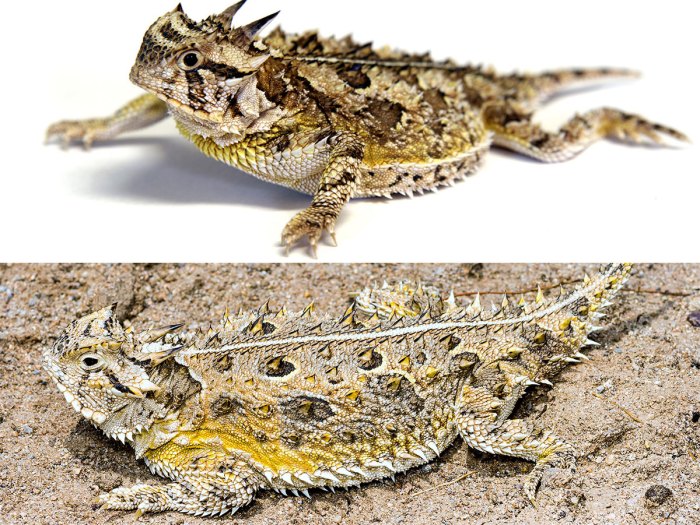
The Texas horned lizard is the easternmost species and the official state reptile of the Lone Star State.
MORE LIFE HACKS
When it rains, horned lizards have another ingenious life hack: They can collect water on their skin by arching their tail over their head. Scales on their tail help channel water down toward their mouth. A handy desert survival trick! Like other reptiles, they can easily overheat on hot days and will move into shade, hide in animal dens or burrow under sand to keep cool. They hibernate underground when temperatures drop in winter.
These lizards are also unusual in how they reproduce. Horned lizards that live in the warmest areas lay eggs, which they bury underground to incubate and hatch on their own. Those in cooler locations and higher elevations incubate eggs internally, and the babies are born looking like miniature adults. Horned lizards may have three to 45 young at a time, depending on the species. Their offspring, which receive no parental care, have fairly low survivorship due to high predation levels. The lifespan of horned lizards is thought to be five to seven years, although legend once held they could live to be 100.
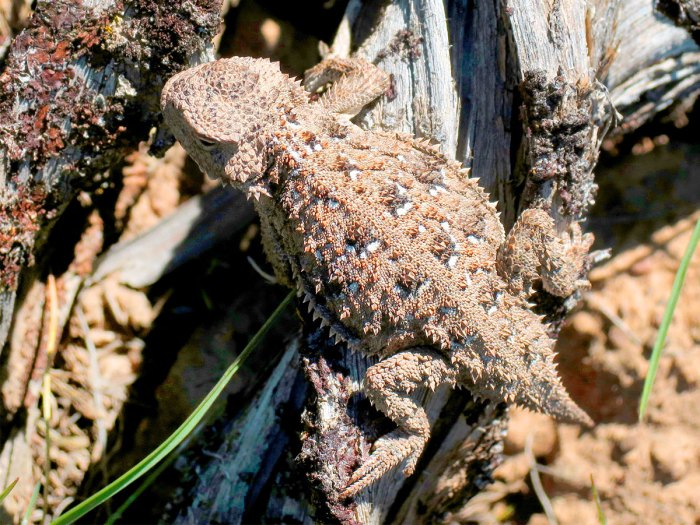
The pygmy short-horned lizard will bury itself in the sand in winter and freeze like an ice cube for months at a time. Then it will thaw out when spring arrives.
BE A CITIZEN SCIENTIST
Many horned lizard populations are declining, so they are protected by law in some states. Major threats include loss of habitat due to development and agriculture, as well as pesticide use and introduction of exotic species. Non-native fire ants have reduced the number of harvester ants in some areas, which takes away from the lizards’ food supply. Fire ants can also kill hatchlings.
The pet trade has removed many horned lizards from the wild as well. They don’t survive well in captivity (do you really want to feed a lizard 100 or more live stinging ants a day?) and therefore don’t make good pets, so please leave them where you find them.
If you would like to help as a citizen scientist, the Horned Lizard Conservation Society wants anyone who encounters these lizards to upload photos — plus date, time and GPS coordinates — to iNaturalist.com. This helps scientists better track their whereabouts and population trends.
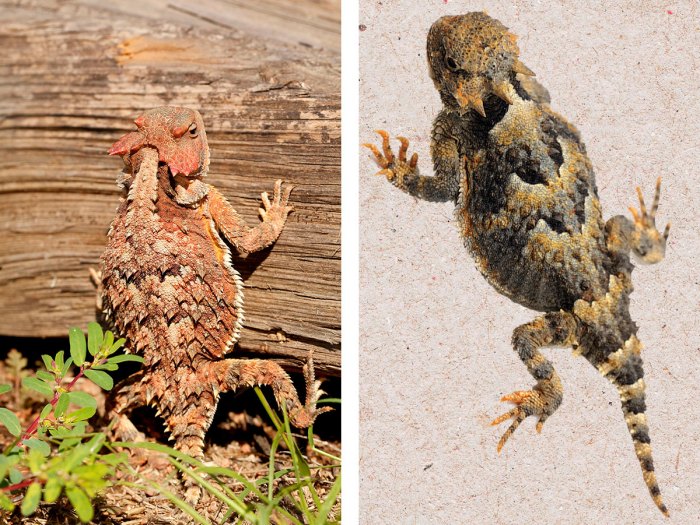
The greater short-horned lizard is the only species that can be found in three countries.
7 FAST FACTS ABOUT HORNED LIZARDS
1. The scientific name for horned lizards — Phrynosoma — means “toadbodied.” Like toads, horned lizards don’t move very fast.
2. Horned lizards were revered by some Native American tribes who used images of them in their artwork.
3. The greater short-horned lizard is the only species that can be found in three countries. It lives in a variety of habitats from 2,000 to 10,000 feet in elevation and is the state reptile of Wyoming.
4. The horns of the regal horned lizard are quite long and resemble a crown.
5. The Texas horned lizard is the easternmost species and the official state reptile of the Lone Star State. They have disappeared from Louisiana and much of East Texas, and possibly from Arkansas and Missouri.
6. The round-tailed horned lizard, like its name hints, has a cylindrical tail with colored bands.
7. Horned lizards come in a wide range of sizes. Not counting tail lengths, the smallest species is the pygmy short-horned lizard (2 ½ inches) and the largest is the giant horned lizard (5 inches). Females are generally bigger than males.
Find out more about U.S. species of horned lizards at hornedlizards.org.
Bats and birds are their specialties, but wildlife biologists Selena Birgit Kiser and Mark Kiser love all species of critters. Both have worked for the State of Florida and previously worked for Bat Conservation International on such programs as the Great Florida Birding and Wildlife Trail and the North American Bat House Research Project.
Leave a Comment